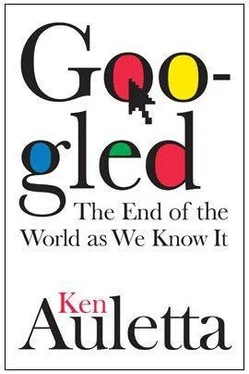Analyzing “the Google” in a deliberate and focused way, we find that while Google may have started out to “do no evil,” it has, to some, morphed from a friendly search engine into something more ominous. Googzilla, fueled by technical prowess, is now on the move.
Where is it moving? The gruff Arnold, who responded to a phone call but refused to speak on the record to anyone who was not paying him, in his book often drops the scientific method in favor of a more fevered tone. Conjuring a monster, he repeatedly refers to the company as “Googzilla,” and writes that “Google stalks a market… then strikes quickly and in a cold-blooded way.” Behind Google’s free food and volleyball games he sniffs a public relations scheme to “misdirect attention. Like a good magician, Google is able to get its audience of competitors and financial analysts to look one way” Meanwhile, “Googzilla is voracious, and it will consume companies presently unaware they are the equivalent of a free-range chicken burrito…”
Arnold and his researchers have uncovered enough information from their study of Google’s patents and algorithms to terrify media companies. As Wal-Mart reshaped retailing, Google, he believes, aims to become a digital Wal-Mart, an online shopping powerhouse that allows consumers to shop for the best price, an essential middleman that offers efficiency and data to advertisers, and shovels revenues to Web sites and services to merchants, including back-office computers that find the quickest and cheapest way to reroute their delivery trucks.
The world would have been better served if its leaders had been more paranoid in the 1930s; media companies would be better served if they were less paranoid and defensive today. If Google is destroying or weakening old business models, it is because the Internet inevitably destroys old ways of doing things, spurs “creative destruction.” This does not mean that Google is not ambitious to grow, and will not grow at the expense of others.
But the rewards, and the pain, are unavoidable. When Google Earth started displaying paintings from the Prado in Madrid, allowing users to zoom in and see the art as an up-close digital photo, it was giving many people access to art they would never see, granting them the time to study paintings that security guards in the bustling museum would never allow them. This was a wonderful opportunity to extend the public’s appreciation of great art. But perhaps we’ll learn that it wasn’t so wonderful for the museum’s box office. Just as the invention of the telephone crushed the telegraph, so motion pictures crippled vaudeville, television eclipsed radio, cable weakened broadcasting, and iTunes shattered CD music album sales. In some cases, new technologies brought new opportunities. The movie studios, after huffing about television, belatedly discovered a lucrative new platform to sell their movies. Exposure on YouTube has broadened the audience for Saturday Night Live. If advertisers can sell their ads more cheaply and better target them through Google, should they fret that they are harming Irwin Gotlieb’s business? What we don’t know is whether the new digital distribution systems will generate sufficient revenue to adequately pay content providers.
David L. Calhoun spent his career at General Electric, where he rose to vice chairman. He left to become chairman and CEO of The Nielsen Company in 2006. When Calhoun joined, Nielsen had long dominated the audience measurement field but was facing a challenge from digital technology, including Google’s. He believes media company executives spend too much time wailing about disintermination. He prefers the word “reintermediate,” because it suggests a company more focused on offense than defense. The companies that “lean in,” he said, are those that embrace change; those who “lean out,” resist it. Companies that concentrate on defense “are frozen,” he said. “If Google’s looking at you, you look like an iceberg. And Google is looking at everybody.”
He does not impute sinister motives to Google, though he treats it like a frenemy: “I genuinely think they just want to empower the consumer. Anything that gets in the way, that blocks a perfectly efficient market, is fair game. If there is a moment they can do something to make the consumer more efficient, they will. And you should know that. But they don’t lie, they don’t cheat, they don’t give head fakes.” Calhoun seeks to collaborate with Google as well as compete, and in 2007 he entered into a partnership to work with Google TV Ads to provide the demographic data that digital set-top boxes do not now yield.
Of course Google is a frenemy to most media companies. Like all companies, Google wants to grow, and growth usually comes from taking a slice of someone else’s business. Because engineers excel at finding efficiencies in the digital world, Google can often offer a more cost-effective solution than companies less focused on engineering. And with 20 percent of their time to concoct new solutions, Google’s engineers are constantly dreaming up ideas-like the young engineer who entered Marissa Mayer’s office in the fall of 2008.
Mayer has one of the most important jobs at Google: to ensure that all Google products are simple and easy for users. She also has an almost photographic memory, the absolute trust of the founders, and joined Google when it was just a year old, so her memory becomes a virtual library of what has worked and what has not, what the founders would and would not want. Mayer sets aside regular open office hours to encourage Google engineers to stop in and describe the 20 percent projects they are working on; it is where they receive her encouragement, or discouragement. On that fall day, a young engineer sat beside her desk and described the device he was working on to search television digital video recorders. He wanted to know two things. Should he develop this as open-source software that others outside Google could tinker with and improve. (Yes.) Second, he needed clarification about something Larry Page had said when he broached the idea at an engineering meeting. Page, who like Brin doesn’t often watch television, expressed impatience with the idea of still another device in the home. Page told the engineer he was thinking too narrowly. The only useful device, he said, would be hardware or software that would allow Google to sell new forms of advertising on any device in the home, from DVRs to TVs to computers. The engineer came to Mayer’s office to better understand the thinking of the founders. The project was code-named Mosaic, and would let Google partner and share ad revenues with cable or telephone companies.
In Google’s way of looking at the world, she explained, any product that simplifies a task for consumers better delivers “the world’s information” to them. Which is another way of saying: Google engineers should imagine that search can be anything that makes a current system more efficient. Searching for a better way to display ads or a better advertising rate-or a better alternate energy source to reduce costs-are forms of search.
The answer is consonant with the Google culture. Understand this Google bias and you’ll better understand why it is a wave-generating company that other media companies ride, crash into, or are submerged by.
“I think they’re naive, not evil,” said CBS’s Quincy Smith. He said his friend Marc Andreessen thinks he’s naive to be so trusting. But Smith doesn’t subscribe to a conspiracy theory because “I don’t think anybody can be that smart.” Not that he’d allow Google to take over CBS’s ad sales function-“That would be letting the fox in the henhouse,” he said. However, having marinated in Silicon Valley for most of his professional life, Smith approaches Google as a potential partner, not adversary. He wants CBS to play offense. Pacing the floor of his new Menlo Park office, he said that media companies fail to understand that Google is a platform. “CBS has sixty-five thousand advertisers, and only fifteen thousand are core advertisers. Google has millions of advertisers.” By placing two- or three-minute clips on YouTube, CBS can sell advertising off those clips. Smith doesn’t believe Google is a content competitor. He does believe that the more CBS places its content on Internet platforms, “the less chance there is for piracy”; a two-minute CSI clip on YouTube watched by two million people is a fantastic way to enlarge CSFs audience. He is encouraged that CBS CEO Les Moonves wants CBS to play offense. Smith, however, was mindful that he was now a member of the broadcast fraternity-and presumably, though he didn’t say it, that his controlling shareholder was Sumner Redstone. “My objective is to be a little bit ahead of the pack, not a lot,” he said.
Читать дальше










